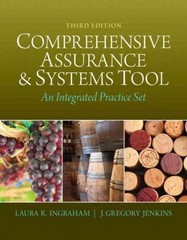Question
LAMBETH CUSTOM CABINETS (A) Jack Lambeth, a master cabinetmaker, owned and operated a shop where he sold custom-made cabinets. At the beginning of September, he
LAMBETH CUSTOM CABINETS (A)
Jack Lambeth, a master cabinetmaker, owned and operated a shop where he sold custom-made cabinets. At the beginning of September, he had no outstanding debts, and the following amounts were on his books:
1. Raw-material inventory, $2,150
2. Supplies inventory, $620
3. Work-in-process inventory, $5,650
Job Materials Labor Overhead(50% of Labor
A-3 $750 $1,100 $550
A- 4 900 650 325
A-5 325 700 350
Total $1,975 $2,450 $1,225 $5,650
4. All other assets as of September 1, $16,890
During the month, Lambeth's woodworking crew finished jobs A-3, A-4, and A-6, but did not complete A-5. Job A-7 was started but not finished during September. Overhead costs( pertaining primarily to equipment and shop depreciation, cleaning supplies, and insurance) were applied to every job at the end of the month unless the job was finished during the month, in which case overhead was applied when the job was finished.
During September, the following direct-materials and direct-labour costs were incurred:
Job Direct Materials Direct Labor
A-3 $280 $750
A-4 3501, 300
A-5 180 550
A-6 375 490
A-7 590 370
Total $1,775 $3,460
Other important financial factors in September were as follows:
1. Raw materials costing $1,675 were purchased during the month.
2. Supplies costing $580 were purchased, of which $490 were used and thus transferred to the manufacturing-overhead account.
3. Total increase to the labour-general-ledger account were $5,460(apparently, $2,000 of indirect-labour costs were charged)
4. General and administrative expenses for the month were $3,420
5. Collections receieved from customers on jobs A-3, A-4, and A-6 amounted to $6,125, $8,600, and $1,750, respectively, for a total of $16,475.
6. At the end of the month, Lambeth Custom Cabinets had no outstanding debts.
Mrs Carter, a neighbour, had stopped by the shop one day in early September to get a price on some cabinets she wanted built. Lambeth's son, Jack Jr. spoke with her. Jack Jr. was working in the shop while on summer vacation between his first and second year of graduate business school. He studied Mrs Carer's plans and estimated the cost of building her cabinets to be $1,625. His job-estimation sheet showed the following:
Lumber $590
Finishing materials 75
Direct-labour cost 640
Overhead 320
Total $1,625
When Jack Jr.quoted a price of $1,900 ($1,625 cost plus $275 profit) to Mrs Carter, she said that she could get the same thing built by Walworth Custom Kitchens for $1,500. Furthermore, she informed him, "I would throw the dumb economics books away before I would pay a penny more than $1,500 for book cabinets to store them"
Jack Jr. simply told her that his best price was $1,900. He explained all about labour, materials, profit, overhead, and competitive capitalism. Also, he told Mrs Carter that Walworth could not make money on a $1,500 price, and if Walworth was really willing to build the shelves for $1,500, she would be stealing from Mr, Walworth!
Mrs Carter was very angry when she left. Jack Jr. later told his father the whole story, and laughed as he said,"Heck, we can't build stuff that costs $1,625 and sell it at $1,600, let alone $1,500, can we?" At the time, Lambeth did not think much about the incident, but he began to wonder whether Jack Jr. had learned anything at graduate business school. Lambeth became especially concerned when he saw Bob Walworth, who said, "Mrs Carter saved me last month." Walworth had just delivered Mrs Carter's new cabinets, for which she paid $1,500. Lambeth wondered who was right: Jack Jr. or Walworth?
1.Create three inventory T-accounts and a Cost of Goods Sold T-account. Show beginning balance, additions, reductions, and ending balance in each t-account. Make sure that you reconcile any under-applied or over-applied overhead to the cost of goods sold.
2In the greatest detail possible, prepare balance sheets as of September 1 and September 30 and an income statement for September (ignore taxes).
3Without changing the expense figures of Mrs Carter's job, under what conditions should Lambeth have accepted the job at a price of $1500? Based on these conditions, what is the maximum possible profit the company could have achieved from this job while charging only $1500? Explain.
Step by Step Solution
There are 3 Steps involved in it
Step: 1

Get Instant Access to Expert-Tailored Solutions
See step-by-step solutions with expert insights and AI powered tools for academic success
Step: 2

Step: 3

Ace Your Homework with AI
Get the answers you need in no time with our AI-driven, step-by-step assistance
Get Started


